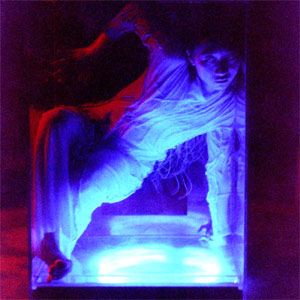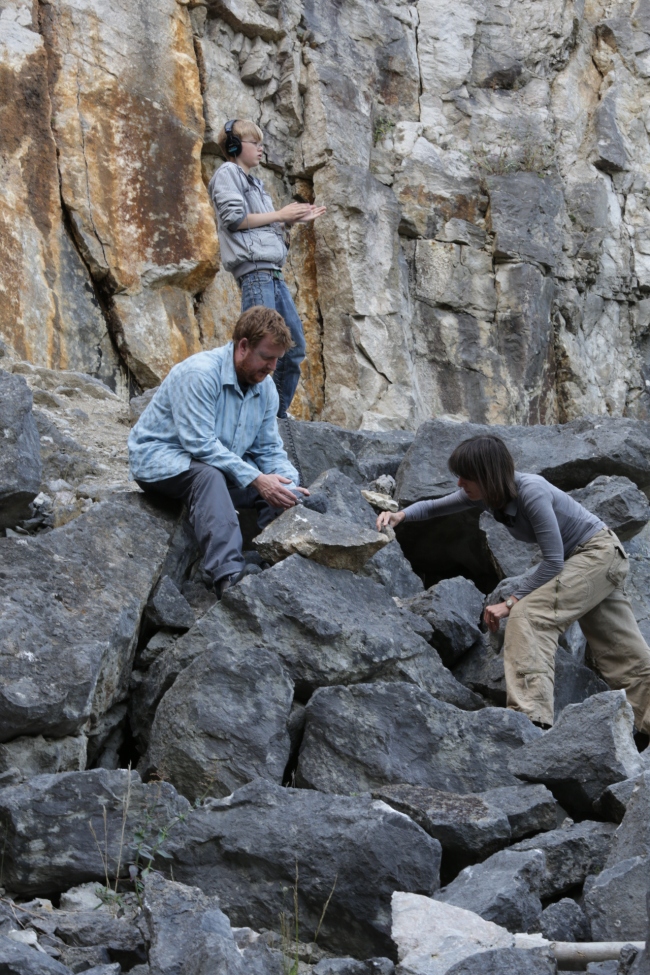
Ad Astra
As part of her role as curator of the international Fragile? symposium, Isabel Jones presents a new site specific performance for Astra our host building at Tallinn University Estonia. The final work is called “Ad Astra” which means , to the stars
Designed to celebrate a European wide community of interest and people who share a passion for this work, Ad Astra brings together all the Fragile choreographers and performers. Fragile? contributors and delegates will also be invited to contribute, via a sound score designed especially for this collective performance.
Isabel works with Salamanda Tandem colleagues photographer: Geoffrey Fielding, Co-composer Duncan Chapman, performer Mickel Smithen, dancer Indra Slavena, and the Estonian String Quartet ‘Amaroza’ to bring this work to Tallinn.
Your creative brief if you wish to accept it
Find a partner to help you get to know the Astra building like a friend. One of you can use sight and the other use touch.
Explore Astra and settle in on a place you feel most at home in or are most interested in exploring.
Taking turns to follow each other, bring the space to life in your minds eye through touch, and listening.
Hold this moment in your imagination. Record this moment with Duncan in words of your mother tongue, then be ready to witness your sound contribution brought to life at 14:00 on Sunday. The context for this is:
Fragile? Symposium
Dance, Arts and Visual Impairment
Tallinn University Estonia
19 to 21 April 2013
Supported by: European Union Culture Programme
Project Coordinator: Bærum Kulturhus
Fragile Project Initiator: Kjersti Kramm Engebrigsten
Project Partners:
Tallinn University, Bærum Kulturhus, Vo’Arte, Salamanda Tandem
Fragile? Symposium Curator: Isabel Jones
Collaboration partners: Dance Theatre Tee Kuubis, Film Studio Ikoon Ltd, Põhja-Eesti Pimedate Ühing [North Estonian Association for the Blind]
Sponsors: Eesti Kultuurkapital [Cultural Endowment of Estonia], Kulturrådet, Arts Council Norway, Governo de Portugal, Secretario de Estado da Cultura [Government of Portugal, Secretary of State for Culture]. National Lottery through Arts Council England, British Council Estonia, Royal Norwegian Embassy Tallinn, DGArtes: Direção-Geral das Artes [Directorate General of the Arts], Norwegian Embassy, Norges Blindeforbund [Norwegian Blind Association], Braille Bureau Nottinghamshire County Council (UK)

Introduction to the symposium programme
Welcome to the Fragile? symposium set here in the beautiful city of Tallinn.
Project partners, Bærum Kulturhus (Norway), Vo’Arte (Portugal), Tallinn University (Estonia) and Salamanda Tandem (England), thank you for joining us to create this European wide gathering of practitioners, participants, artists, and academics, engaged in the fields of dance, art and visual impairment.
We aim throughout the Fragile? symposium to encourage debate, participation, provocation, and appreciation of the contributions of visually impaired people and their collaborative partners in the fields of dance, performance, wellbeing and art.
The symposium programme has been brought together by our Fragile? curator, Isabel Jones, who, in shaping the themes and working closely with partners and contributors, has devised a fascinating event for us consisting of more than 25 separate participatory experiences, inclusive presentations, exhibits and performances.
Events will be presented by an exciting array of visually impaired and sighted experts from all over Europe debating, showing, and performing their work in response to the symposium themes.
Symposium Themes
Art: an inclusive aesthetic
How inclusive is dance as an art form for visually impaired people? What are we doing to make it more so? What affects are there on the ‘Art’ of an inclusive aesthetic?
Training and Work: routes and barriers
What shifts are needed both attitudinal and physical for visually impaired people to enter the performing arts as professionals? Where, for whom, and how has it been done well?
Wellbeing: value and appreciation
Is dance/art valuable to visually impaired people and, if so, how? How far does this value extend, and does it extend to audiences?

Background to the Symposium: Fragile becomes Fragile?
The symposium marks the culmination of a landmark EU funded project, founded by the Norwegian choreographer Kjersti Kramm Engebrigtsen named “Fragile”. Kjersti stimulated by a desire to share her experiences of dance with blind people Europe wide, and the fragility of this work, invited Estonian choreographer Ajjar Ausma and Portuguese choreographer Ana Rita Barata to join her in developing the project.
Morten Walderhaug from Bærum Kulturhus (Norway) provided the bedrock of support to raise EU money and bring Vo’Arte (Portugal), Tallinn University (Estonia) and Salamanda Tandem (UK) on board to realise the project.
In 2011 Kjersti, Ana Rita and Ajjar started work, supported by project partners and coordinators Marianne Bilger, Clara Antunes and Karmen Ong. Crossing art as well as country borders, the team included composers, costume and lighting designers, and documentary filmmakers from different countries. Local visually impaired people, dance teachers and specialist educators in the field of visual impairment were closely involved whilst, Kjersti, held local workshops in collaboration with Ajjar and Ana Rita in Portugal, Norway and Estonia. The process was designed to anchor the project within local populations in each country, and help develop infrastructure to support the creativity of visually impaired people, through access to professional dancers and choreographers. This work resulted in three new choreographic works: “Touched” (Kjersti K Engebrigsten), “Edge” (Ana Rita Barata) and “Plexus” (Ajjar Ausma). Premiered on 30th March 2013 in Lisbon, then performed in Oslo and now in Tallinn at Kumu.
As part of the process Kjersti, Ana and Ajjar invited English choreographer Isabel Jonesto Norway. Inspired by her 30 years of practice and lived experience of the work, she was invited to become curator of this final symposium event to expand the potential of the project to include others. Isabel then introduced a ? suggesting the potential of Fragile? to be a centre for debate and enquiry.
Please find our detailed programme and information on all the Fragile? symposium contributors from page 5 of this booklet. FRAGILE? Symposium PROGRAMME
http://www.tlu.ee/fragile
Full List of Fragile? Symposium and Ad Astra Contributors
Kjersti K. Engebrigtsen (NORWAY) FRAGILE project Artistic Director, Choreographer of “TOUCHED”
Isabel Jones (ENGLAND) Artistic Director, Salamanda Tandem; FRAGILE? Symposium Curator; Director of site-specific performance “Ad Astra”
Ana Rita Barata (PORTUGAL) Choreographer of “EDGE”, Vo’Arte
Ajjar Ausma (ESTONIA) Choreographer of “PLEXUS”
Mick Wallis (ENGLAND) Professor & Chair in Performance and Culture, University of Leeds
Kaite O’Reilly (WALES) Playwright
Joselia Neves (PORTUGAL) Coordinating Professor, Instituto Politécnico de Leiria
Katy Dymoke (ENGLAND) Artistic Director, TOUCHDOWN
Dr David Feeney (SCOTLAND) Senior Researcher Fellow, Edinburgh University; Manager, Visual Impairment Scotland
Lee Sass (ENGLAND) Artist
Delphine Demont (FRANCE) Artistic Director, ACAJOU
José Luis Pagés (FRANCE) Artistic Collaborator, ACAJOU
Maria Oshodi (ENGLAND) Artistic Director, EXTANT
Per Solvang (NORWAY) Sociologist and Professor, University College of Oslo
Gregor Strutz (GERMANY) Artist
Sarah Kettley (ENGLAND) Senior Lecturer, Nottingham Trent University
Saïd Gharbi (BELGIUM) Choreographer and Dancer
Ana Stegnar (SLOVENIA) Choreographer and Dancer
Rachel Gadsden (ENGLAND) Visual Artist
Dijana Raudoniene (LITHUANIA) Post-doctoral Researcher, Vilnius Academy of the Arts; NGO Culture Artfact
Mickel Smithen (ENGLAND) Dancer “Ad Astra” Salamanda Tandem
Izabela Morska (POLAND) Writer; Academic, Gdansk University
Erik Loide (ESTONIA) Chairman of the Council, Estonian Foundation for the Visually Impaired; Accessibility Expert
Ülle Lepp (ESTONIA) Chair of the Board, Estonian Foundation for the Visually Impaired; Researcher of the non-profit sector
Kristin Kurtna (ESTONIA) Line-dance Instructor, NGO Huviline
Sülvi Sarapuu (ESTONIA) Expert in tactile books and audio description, NGO Kakora
Riho Roosioja (ESTONIA) Public Administration Master Student, Tallinn University
Kirke-Anneli Kuld (ESTONIA) Arts Therapy Student, Tallinn University
Indra Slavena (LATVIA) Dancer of “Ad Astra” Salamanda Tandem
Duncan Chapman (ENGLAND) Artist; Performer and composer of “Ad Astra” Salamanda Tandem
Geoffrey Fielding (ENGLAND) Photographer, Salamanda Tandem
Maria Lloyd (NORWAY) Film Maker of “Into The Unknown”
Pedro Sena Nunes (PORTUGAL) Film Maker of “Edge”; Co-Artistic Director, Vo’Arte
Vahur Laiapea (ESTONIA) Film Maker of “See You On Stage”; Film Director/Producer, Film studio Ikoon
Nina Biong (NORWAY) dancer of “TOUCHED”
Geir Hytten (NORWAY) dancer of “TOUCHED”
Hege Eidseter (NORWAY) dancer of “TOUCHED”
Katja Schia (NORWAY) dancer of “TOUCHED”
Alexander Aarø (NORWAY) dancer of “TOUCHED”
Bernardo Gama (PORTUGAL) dancer of “EDGE”
Sofia Soromenho (PORTUGAL) dancer of “EDGE”
Luís Oliveira (PORTUGAL) dancer of “EDGE”
Joana Gomes (PORTUGAL) dancer of “EDGE”
Jaan Ulst (ESTONIA) dancer of “PLEXUS”
Kärt Tõnisson (ESTONIA) dancer of “PLEXUS”
Hedy Haavalaid (ESTONIA) dancer of “PLEXUS”
Marianne Bilger (NORWAY) FRAGILE Project Manger, Bærum Kulturhus
Morten Walderhaug (NORWAY) FRAGILE Project Leader; Artistic and Managing Director, Bærum Kulturhus
Karmen Ong (ESTONIA) FRAGILE project Estonian Coordinator, Tallinn University
Eveli Kuuse (ESTONIA) FRAGILE project Estonian Communication Manager
Karin Org (ESTONIA) – FRAGILE? Symposium Co-organiser, Tallinn University Conference Centre
Clara Antunes (PORTUGAL) – FRAGILE project Portuguese Coordinator, Vo’Arte
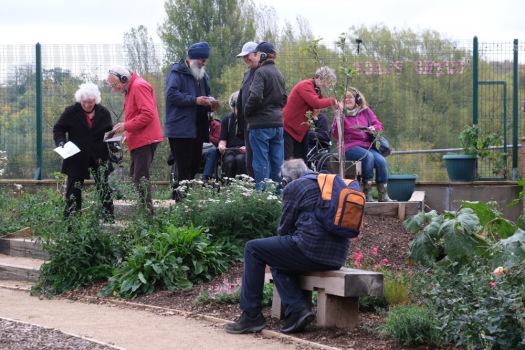 9th Oct 13.00 and 16th October 2018 13.0 – 13.45 and 15.00 – 15.45
9th Oct 13.00 and 16th October 2018 13.0 – 13.45 and 15.00 – 15.45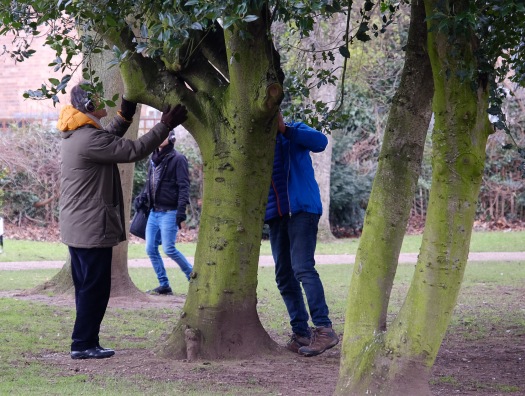

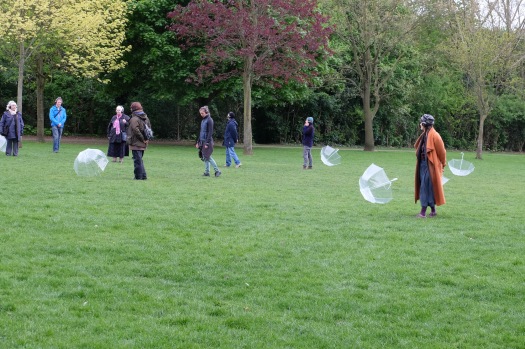 Salamanda Tandem’s ‘Soundwalks into Wellbeing’, are a series of outdoor site specific performances, with radio headphones. Tailor-made for each season, and taking place in our local city park, right opposite Salamanda Tandem’s home in West Bridgford, Nottingham. Designed by soundartists, wellbeing practitioners and seldom heard carers, who collaborate together to develop their own wellbeing, and that of others, to address the challenges of isolation, stress, disability and poor health.
Salamanda Tandem’s ‘Soundwalks into Wellbeing’, are a series of outdoor site specific performances, with radio headphones. Tailor-made for each season, and taking place in our local city park, right opposite Salamanda Tandem’s home in West Bridgford, Nottingham. Designed by soundartists, wellbeing practitioners and seldom heard carers, who collaborate together to develop their own wellbeing, and that of others, to address the challenges of isolation, stress, disability and poor health.


















